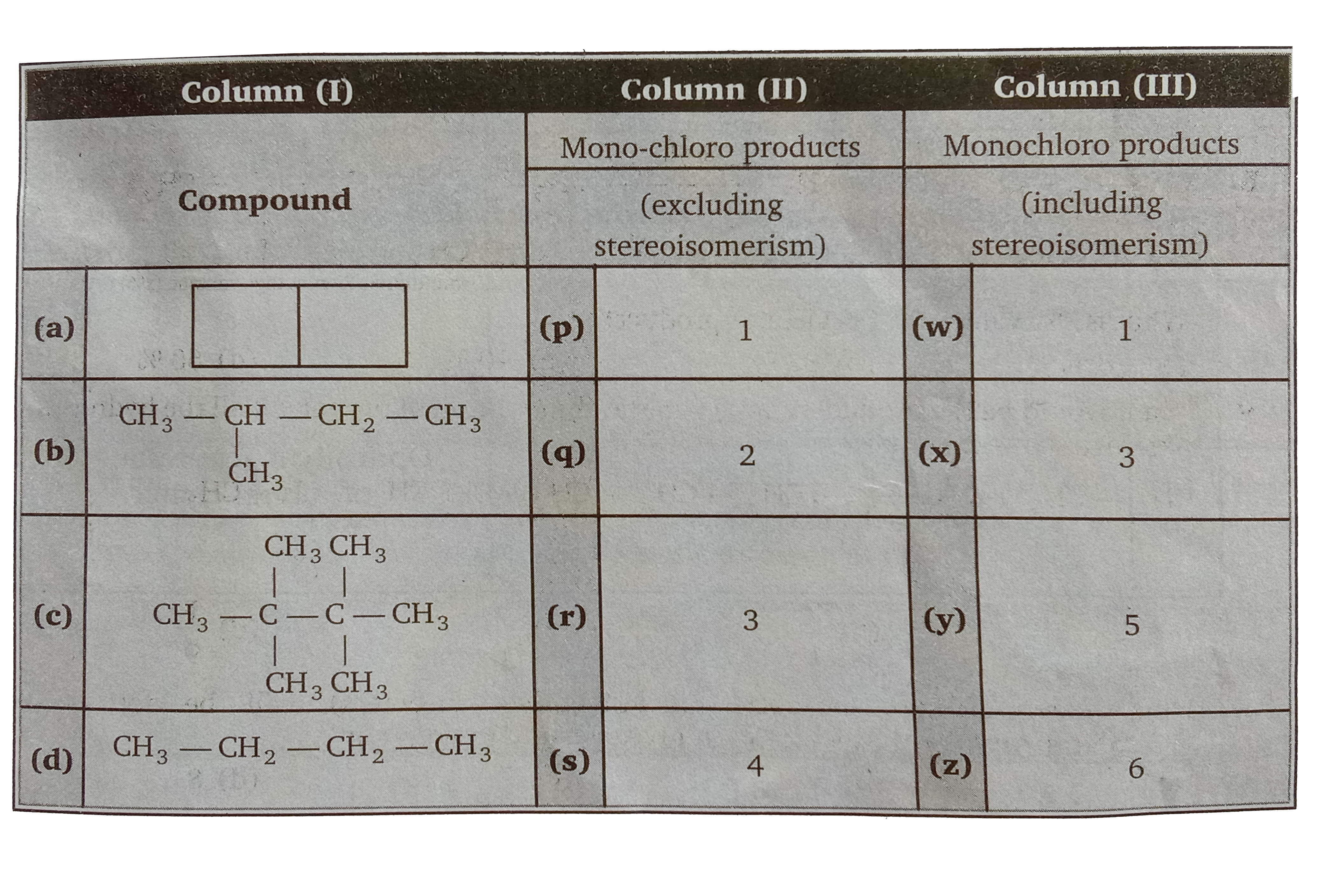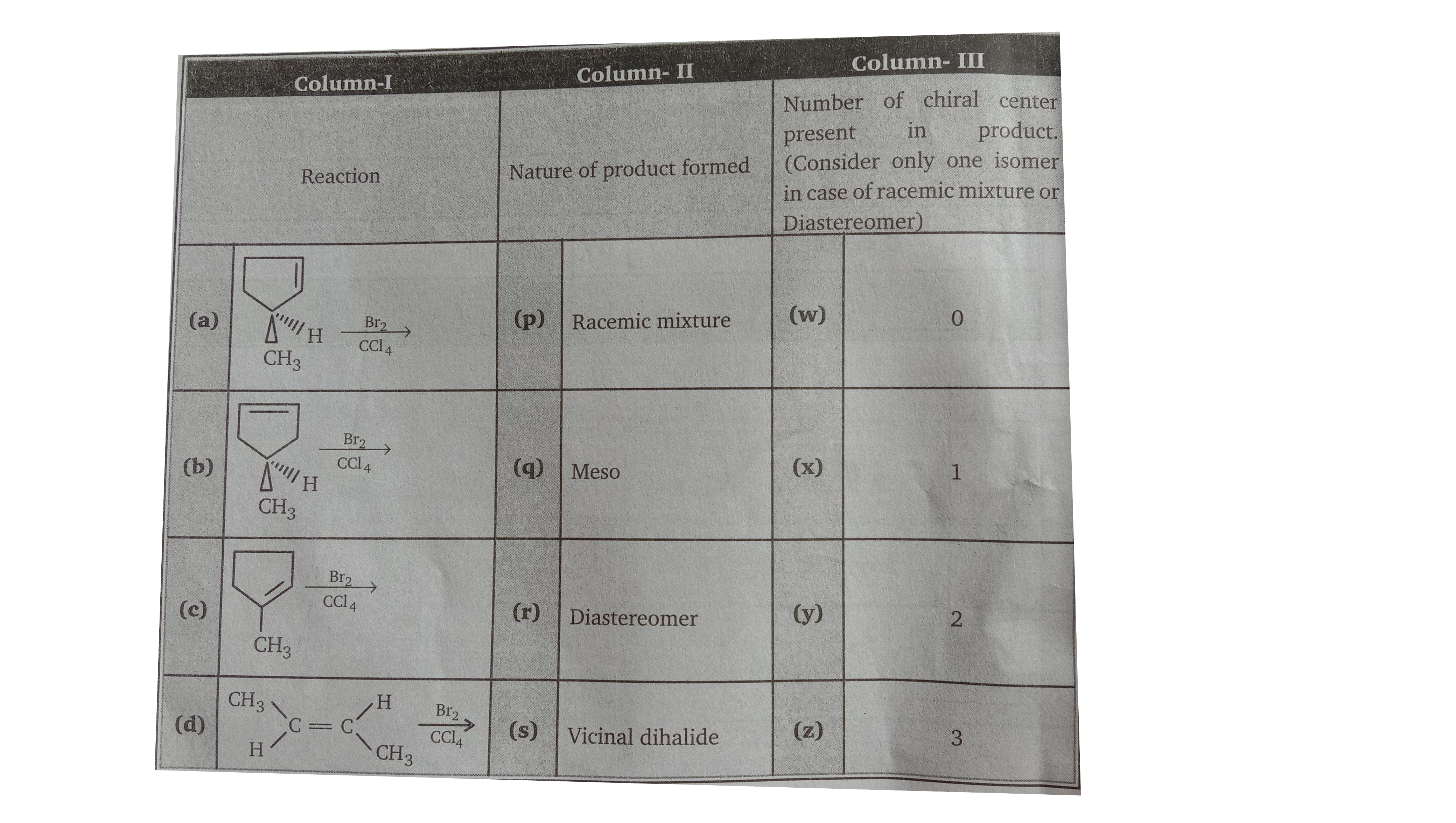Match the following columns
Column IColumn IIa. Cisacontic acidI. 2-carbonb. Fumaric acidII. 3-carbonc. 2-PGAIII. 4-carbond. Acetyl CoAIV. 6-carbon
a-I, b-II, c-III, d-IV
a-II, b-III, c-I, d-IV
a-IV, b-III, c-I, d-II
a-IV, b-III, c-II, d-I
The correct Answer is:D
To solve the matching question, we need to identify the number of carbon atoms in each compound listed in Column I and then match them with the corresponding number of carbon atoms in Column II.
1. Identify the number of carbons in Cisacontic acid:
- Cisacontic acid is a 6-carbon compound.
- Match: This corresponds to IV (6-carbon).
2. Identify the number of carbons in Fumaric acid:
- Fumaric acid is a 4-carbon compound.
- Match: This corresponds to III (4-carbon).
3. Identify the number of carbons in 2-PGA (2-phosphoglycerate):
- 2-PGA has 3 carbon atoms.
- Match: This corresponds to II (3-carbon).
4. Identify the number of carbons in Acetyl CoA:
- Acetyl CoA is a 2-carbon compound.
- Match: This corresponds to I (2-carbon).
Final Matches:
- a. Cisacontic acid → IV (6-carbon)
- b. Fumaric acid → III (4-carbon)
- c. 2-PGA → II (3-carbon)
- d. Acetyl CoA → I (2-carbon)
Answer:
- a → IV
- b → III
- c → II
- d → I
- Cisacontic acid is a 6-carbon compound.
- Match: This corresponds to IV (6-carbon).
- Fumaric acid is a 4-carbon compound.
- Match: This corresponds to III (4-carbon).
- 2-PGA has 3 carbon atoms.
- Match: This corresponds to II (3-carbon).
- Acetyl CoA is a 2-carbon compound.
- Match: This corresponds to I (2-carbon).
- a. Cisacontic acid → IV (6-carbon)
- b. Fumaric acid → III (4-carbon)
- c. 2-PGA → II (3-carbon)
- d. Acetyl CoA → I (2-carbon)
- a → IV
- b → III
- c → II
- d → I
Similar Questions
Knowledge Check
- Question 1 - Select One
Match the following Columns.
Column IColumn IIA. DDT1. CO, CO2B. PAN2. smogC. Acid rain3. Biological magnificationD. Global warming4. SO2AABCD4321BABCD1234CABCD2341DABCD3241 - Question 2 - Select One
Match the column-
Column IColumn IIA Toxinsi. MorphineB Alkaloidsii. AbrinC Lectinsiii. VinblastinD. Drugsiv. Concanavalin A
ABCDiiiiiiiviiiiiiiviiiiviiiviiiiiiA1B2C3D4 - Question 3 - Select One
Match the following columns:
Column IColumn IIa.Oxylophytes(i)Calcium-rich soilsb.Eremophytes(ii)Waste landc.Chrysophytes(iii)Deserts, steppesd.Calciphytes(iv)Acidic soilsAa (i), b (ii), c (iii), d (iv)Ba (i), b (iii), c (iv), d (ii)Ca (iv), b (iii), c (ii), d (i)Da (iv), b (iii), c (i), d (ii)
Match the column I and II
Column IColumn II(a) Apocarpous(i) Papaver(b) Syncarpous(ii) Michellia(c) Epiphyllous(iii) Cashew(d) Cotyledon(iv) AloeView SolutionMatch the following Columns
Column IColumn IIA.Collateral and open(i)Cucubita stemB.Radial(ii)FernC.Bicollateral(iii)Maize rootD.Concentric(iv)Sunflower(v)Maize stemView SolutionMatch the following columns:
Column IColumn IIAGolden riceiEli LilyBPCRiiHerbert boyerCInsuliniiiKary mullisDRecombinivPeter BayerView SolutionMatch the following columns
Column IColumn IIa.Lysozyme(i)HClb.Peptic cells(ii)Antibacterial enzymec.Saliva(iii)Sublingual glandd.Oxyntic cells(iv)PepsinogenView SolutionMatch theentries of Column 1 with those of Column 2.
Column 1Column 2A. Bulb(i) Sweet potatoB. Tuber(ii) BryophyllumC. Root(iii) OnionD. Leaf(iv) PotatoView Solution



